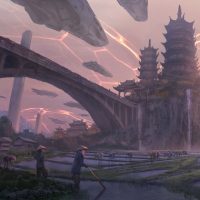Robert Holdstock: fantasy fiction writer

Although he wrote more than 40 books in a career that began in the mid-1970s, Robert Holdstock will probably always be best known as the author of Mythago Wood, a novel in which a patch of primeval English woodland is revealed as a gateway into the human subconscious, and the birthplace of myth. Michael Moorcock called it “the outstanding fantasy book of the 1980s”, and it won the British Science Fiction Award, the World Fantasy Award, and, as La Forêt des Mythagos, was awarded a special Grand Prix de l’imaginaire.
Robert Paul Holdstock was born in Kent, in 1948, the oldest of five children. The English countryside, and stories told by his grandfather, sparked his imagination as a child and remained a lasting source of inspiration. But he was drawn first to study science, and received a BSc with honours in applied zoology from University College of North Wales, and then an MSc in medical zoology from the London School of Hygiene in 1971. While a student, he became involved in science fiction fandom, and sold his first short story to New Worlds, the magazine, in 1968.
After several years doing medical research, Holdstock took the plunge and became a full-time freelance writer in 1975. His first novels under his own name, Eye Among the Blind and Earthwind, were science fiction, but in order to make a living he also wrote many other books, including TV and movie tie-ins, under various pseudonyms.
Some of those quickly written, commercial fictions — particularly the Raven swords-and-sorcery series attributed to “Richard Kirk” and the Berserker series by “Chris Carlsen” — achieved a popularity that surprised and slightly embarrassed him. Yet for all their flaws they don’t resemble hack work; John Clute, writing in The Encyclopedia of Fantasy, described these books as “so exuberantly full of action that they seem almost libidinous with release”.
In 1979, needing something to bring to the annual Milford writers’ conference, he wrote a short story about mysterious apparitions from the imaginary Ryhope Wood. As soon as it was finished, he said: “I had the whole novel in my head.”
Another science fiction novel, Where Time Winds Blow, came first, but in 1984 Mythago Wood was published. The premise of this fantasy is that time and space are different at the heart of this ancient wood, and those able to penetrate it encounter beings from the collective unconscious, at first recognisable figures such as King Arthur or Robin Hood, but eventually more primal beings, monsters from the earliest dreams of stone age people. These are “mythagos”, or living myth-images.
Mythago Wood was dedicated to Holdstock’s partner, Sarah Biggs, and 1984, when it was published, marked the beginning of their life together in their North London home.
Although he had no intention of writing a sequel, Holdstock returned to Ryhope Wood a few years later in Lavondyss, in part a magical, female coming-of-age story, much darker and more disturbing than the first book, and thought by many to be an even greater achievement. Avilion, published this year, was a direct sequel to Mythago Wood, following the fates of its main characters, and the adventures of their children.
In addition to the five books that make up the Mythago cycle (“the sequence as a whole is a central contribution to late 20th-century fantasy” according to the Encyclopedia of Fantasy), Holdstock wrote three volumes of the Merlin Codex: Celtika, The Iron Grail and The Broken Kings, an adventurous reimagining of the Matter of Britain combined with Ancient Greek legends, bringing Merlin together with Jason and Medea. The Ragthorn, a novella written in collaboration with Garry Kilworth, created an entire imaginary mythos around a thorn tree and won both the British Science Fiction Award and the World Fantasy Award in 1992.
In fantasy he revealed his greatest imaginary powers, yet he always brought the conceptual rigour of the scientist to his work. He was fascinated by mythology and history, by the origins of language and the power of story in individual lives. His work was always more complex than most genre fantasy, never glorifying violence or settling for easy answers, always aware of a mystery at the heart of life.
Besides being one of the most significant authors in modern British fantasy, Robert Holdstock — often known as Rob — was widely loved. He made a lasting impression on everyone who met him, and will be remembered not only for his books, but also for his kind and ebullient personality. He had many enthusiasms, and loved to share them. He was enormously generous with his time and energy, loved to invent elaborate games for the younger members of his extended family, encouraged new writers and was a constant, sustaining presence for a wide network of friends.
He was writing poetry, working on a new novel, and full of ideas for the books he intended to write when he began feeling ill. Within days, he collapsed with major organ failure.
Holdstock’s 1973 marriage to Sheila Cummins-Kavanagh ended after an amicable separation in 1981. He is survived by his partner, Sarah Biggs.




